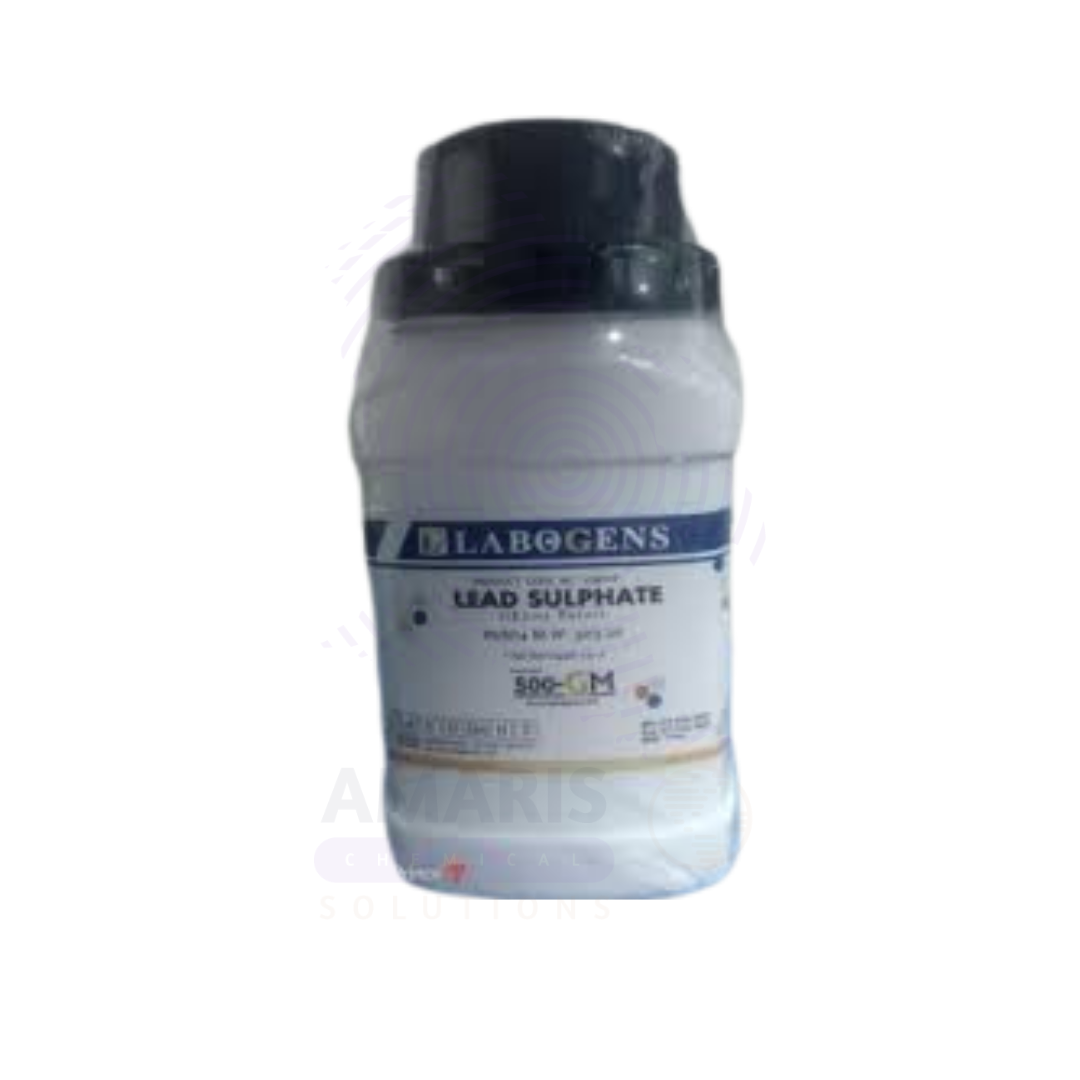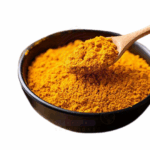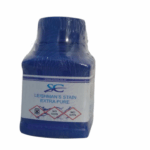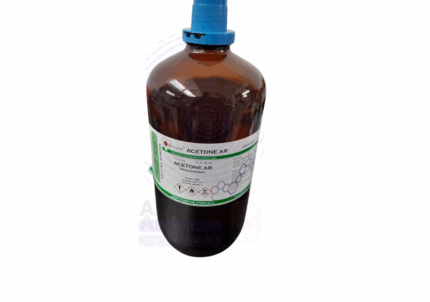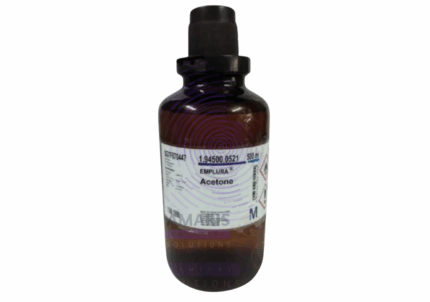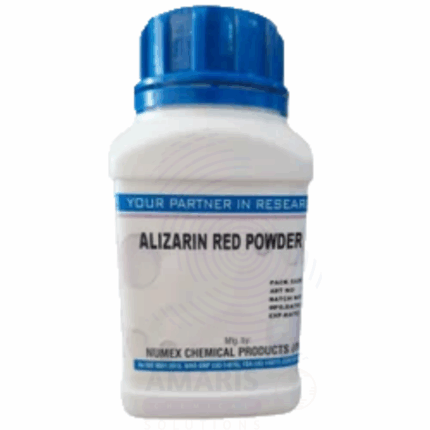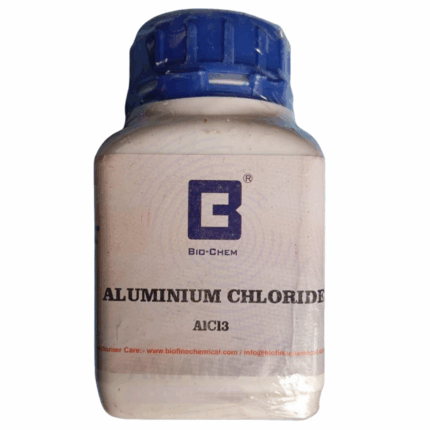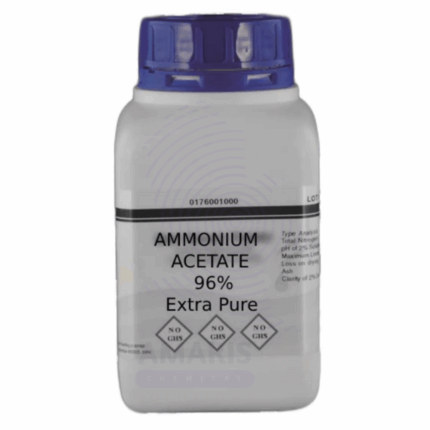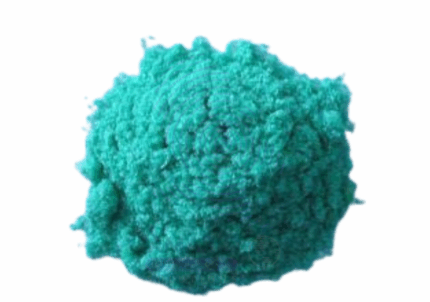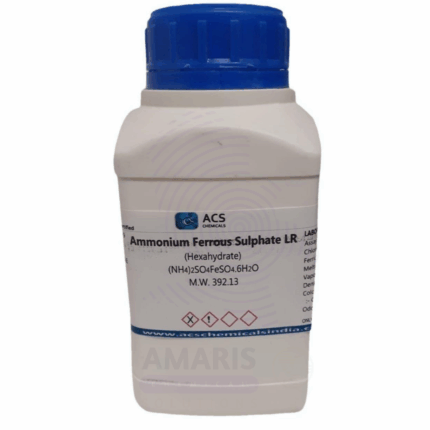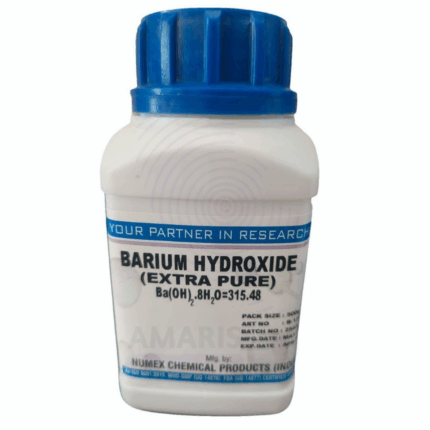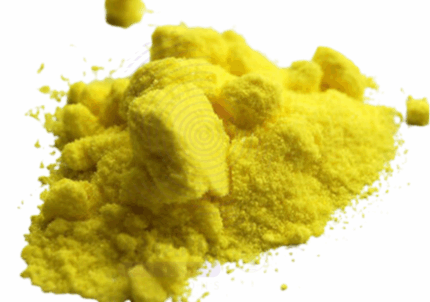Lead Sulphate Extra Pure
$ 17.10 Original price was: $ 17.10.$ 16.98Current price is: $ 16.98.
Lead Sulphate Extra Pure is a fine, white crystalline powder composed of highly purified lead(II) sulfate (PbSO₄), valued for its stability and controlled chemical properties. It is primarily used in analytical chemistry, electrochemical research, and in the manufacture of lead-acid batteries, where it plays a key role in the discharge and recharge cycles. Its low solubility in water makes it suitable for precipitation reactions, and it’s also utilized in the study of insoluble salts in academic laboratories. Despite its stability, lead sulphate is toxic if inhaled or ingested, and appropriate safety measures—such as gloves, masks, and proper ventilation—must be enforced during handling and storage.
Lead Sulphate Extra Pure
Primary Uses
- Analytical Chemistry Reference:
- Used as a standard or reference compound in qualitative and quantitative analysis of lead or sulfate ions.
- Electrochemical Research:
- Commonly studied in electrochemistry due to its role in the lead-acid battery cycle, particularly in research on battery degradation and recharge cycles.
- Inorganic Reaction Studies:
- Serves as a reactant or product in double displacement reactions and solubility experiments, especially because of its poor water solubility.
Secondary Uses
- Toxicology and Environmental Testing:
- Used in research investigating heavy metal contamination, bioavailability, and leachability of lead compounds in environmental samples.
- Material Science Studies:
- Evaluated for crystal structure and phase transformation behavior under various thermal or chemical treatments.
- Demonstration of Precipitation Reactions:
- Ideal for classroom or laboratory demonstrations involving precipitation of insoluble salts (e.g., reaction between lead nitrate and sulfuric acid).
| PACK SIZE |
500 grams Plastic Tin |
|---|
1. Basic Identification Attributes
- Chemical Name: Lead(II) Sulphate
- Synonyms: Lead Sulfate, Plumbous Sulfate
- Chemical Formula: PbSO₄
- CAS Number: 7446-14-2
- Molecular Weight: 303.26 g/mol
- Grade: Extra Pure (Laboratory/Analytical Grade)
- Appearance: White or grayish-white crystalline powder
- Odor: Odorless
- Solubility: Insoluble in water and alcohol; soluble in concentrated acids
2. Safety & Hazard Attributes
- GHS Classification:
- Reproductive toxicity – Category 1A
- Specific target organ toxicity (repeated exposure) – Category 2
- Acute aquatic toxicity – Category 1
- Chronic aquatic toxicity – Category 1
- Hazard Statements:
- H360: May damage fertility or the unborn child
- H373: May cause damage to organs through prolonged or repeated exposure
- H400: Very toxic to aquatic life
- H410: Very toxic to aquatic life with long lasting effects
- Precautionary Statements:
- P201: Obtain special instructions before use
- P260: Do not breathe dust
- P273: Avoid release to the environment
- P280: Wear protective gloves and eye protection
- P308+P313: If exposed or concerned: Get medical advice
- Personal Protective Equipment (PPE):
- Gloves, safety goggles, lab coat
- Dust mask or respirator in case of airborne dust
- Use under fume hood if possible
- First Aid Measures:
- Inhalation: Move to fresh air; seek medical attention
- Skin Contact: Wash with soap and water
- Eye Contact: Rinse with water for several minutes
- Ingestion: Do not induce vomiting; seek medical help immediately
- Fire Hazards:
- Not flammable
- Emits toxic fumes of lead and sulfur oxides when heated
3. Storage & Handling Attributes
- Storage Conditions:
- Store in a tightly sealed container
- Keep in a cool, dry, well-ventilated area
- Store away from acids and incompatible materials
- Handling Tips:
- Avoid dust formation
- Avoid contact with skin and eyes
- Handle with proper PPE and good lab hygiene
4. Laboratory Applications
- Primary Uses:
- Preparation of other lead compounds in synthesis
- Reagent in analytical chemistry and gravimetric analysis
- Used in lead-acid battery research
- Secondary Uses:
- Teaching demonstrations involving insoluble salts
- Component in pigment and glass research
- Toxicology and heavy metal testing studies
SAFETY PRECAUTIONS
Personal Protective Equipment (PPE):
- Wear a lab coat, chemical-resistant gloves (nitrile or neoprene), and safety goggles.
- Use a dust mask or operate in a fume hood if there’s a risk of airborne particles.
Handling:
- Handle with care—toxic if ingested or inhaled.
- Avoid generating or breathing dust.
- Do not eat, drink, or smoke while using this chemical.
- Wash hands thoroughly after handling and before breaks or meals.
Storage:
- Store in a tightly sealed container in a cool, dry, and well-ventilated area.
- Keep away from acids, moisture, and foodstuff.
- Label and secure storage for toxic substances.
FIRST AID MEASURES
Inhalation:
- Move the person to fresh air.
- If breathing is difficult, seek medical attention.
- Administer oxygen if trained and needed.
Skin Contact:
- Wash the affected area with plenty of soap and water.
- Remove contaminated clothing.
- Get medical advice if irritation or symptoms develop.
Eye Contact:
- Rinse cautiously with clean water for at least 15 minutes.
- Remove contact lenses if easy to do.
- Seek immediate medical attention.
Ingestion:
- Do not induce vomiting.
- Rinse mouth with water.
- Seek urgent medical attention—lead compounds are highly toxic.
FIRE FIGHTING MEASURES
Flammability:
- Non-combustible; however, it may emit toxic fumes when heated.
Extinguishing Media:
- Use extinguishing agents appropriate for surrounding fire (dry chemical, CO₂, water spray, foam).
Hazardous Combustion Products:
- May release lead oxides and sulfur oxides (SOₓ) upon decomposition.
Firefighter Protection:
- Wear self-contained breathing apparatus (SCBA) and full protective gear.
- Avoid inhalation of any combustion gases or contaminated dust.


 Preservatives(food)
Preservatives(food) Flavor Enhancers
Flavor Enhancers Acidulants
Acidulants Sweeteners
Sweeteners Antioxidants
Antioxidants Colorants(food)
Colorants(food) Nutraceutical Ingredients (food)
Nutraceutical Ingredients (food) Nutrient Supplements
Nutrient Supplements Emulsifiers
Emulsifiers
 Collectors
Collectors Dust Suppressants
Dust Suppressants Explosives and Blasting Agents
Explosives and Blasting Agents Flocculants and Coagulants
Flocculants and Coagulants Frothers
Frothers Leaching Agents
Leaching Agents pH Modifiers
pH Modifiers Precious Metal Extraction Agents
Precious Metal Extraction Agents
 Antioxidants(plastic)
Antioxidants(plastic) Colorants (Pigments, Dyes)
Colorants (Pigments, Dyes) Fillers and Reinforcements
Fillers and Reinforcements Flame Retardants
Flame Retardants Monomers
Monomers Plasticizers
Plasticizers Polymerization Initiators
Polymerization Initiators Stabilizers (UV, Heat)
Stabilizers (UV, Heat)
 Antifoaming Agents
Antifoaming Agents Chelating Agents
Chelating Agents Coagulants and Flocculants
Coagulants and Flocculants Corrosion Inhibitors
Corrosion Inhibitors Disinfectants and Biocides
Disinfectants and Biocides Oxidizing Agents
Oxidizing Agents pH Adjusters
pH Adjusters Scale Inhibitors( water)
Scale Inhibitors( water)
 Antioxidants(cosmetic)
Antioxidants(cosmetic) Emollients
Emollients Fragrances and Essential Oils
Fragrances and Essential Oils Humectants
Humectants Preservatives
Preservatives Surfactants(cosmetic)
Surfactants(cosmetic) Thickeners
Thickeners UV Filters
UV Filters
 Fertilizers
Fertilizers Soil Conditioners
Soil Conditioners Plant Growth Regulators
Plant Growth Regulators Animal Feed Additives
Animal Feed Additives Biostimulants
Biostimulants Pesticides (Herbicides, Insecticides, Fungicides)
Pesticides (Herbicides, Insecticides, Fungicides)
 Active Pharmaceutical Ingredients (APIs)
Active Pharmaceutical Ingredients (APIs) Excipients
Excipients Solvents(pharmaceutical)
Solvents(pharmaceutical) Antibiotics
Antibiotics Antiseptics and Disinfectants
Antiseptics and Disinfectants Vaccine Adjuvants
Vaccine Adjuvants Nutraceutical Ingredients (pharmaceutical)
Nutraceutical Ingredients (pharmaceutical) Analgesics & Antipyretics
Analgesics & Antipyretics
 Analytical Reagents
Analytical Reagents Solvents(lab)
Solvents(lab) Chromatography Chemicals
Chromatography Chemicals Spectroscopy Reagents
Spectroscopy Reagents microbiology-and-cell-culture-reagents
microbiology-and-cell-culture-reagents Molecular Biology Reagents
Molecular Biology Reagents Biochemical Reagents
Biochemical Reagents Inorganic and Organic Standards
Inorganic and Organic Standards Laboratory Safety Chemicals
Laboratory Safety Chemicals Specialty Laboratory Chemicals(Special Laboratory Equipment)
Specialty Laboratory Chemicals(Special Laboratory Equipment)
 Demulsifiers
Demulsifiers Hydraulic Fracturing Fluids
Hydraulic Fracturing Fluids Scale Inhibitors(oil)
Scale Inhibitors(oil) Surfactants(oil)
Surfactants(oil) Drilling Fluids
Drilling Fluids
 Dyes and Pigments
Dyes and Pigments Bleaching Agents
Bleaching Agents Softening Agents
Softening Agents Finishing Agents
Finishing Agents Antistatic Agents
Antistatic Agents
 Admixtures
Admixtures Waterproofing Agents
Waterproofing Agents Sealants and Adhesives
Sealants and Adhesives Curing Compounds
Curing Compounds Concrete Repair Chemicals
Concrete Repair Chemicals Anti-Corrosion Coatings
Anti-Corrosion Coatings
 Surfactants(cleaning)
Surfactants(cleaning) Builders
Builders Enzymes
Enzymes Solvents (Cleaning)
Solvents (Cleaning) Fragrances
Fragrances
 Electronic Chemicals
Electronic Chemicals Catalysts
Catalysts Lubricants
Lubricants Photographic Chemicals
Photographic Chemicals Refrigerants
Refrigerants Automotive chemicals
Automotive chemicals Pyrotechnic Chemicals
Pyrotechnic Chemicals
 Biodegradable Surfactants
Biodegradable Surfactants Bio-based Solvents
Bio-based Solvents Renewable Polymers
Renewable Polymers Carbon Capture Chemicals
Carbon Capture Chemicals Wastewater Treatment Chemicals
Wastewater Treatment Chemicals
 Pigments
Pigments Solvents(paint)
Solvents(paint) Specialty Coatings
Specialty Coatings Binders/Resins
Binders/Resins Additives
Additives Driers
Driers Anti-Corrosion Agents
Anti-Corrosion Agents Functional Coatings
Functional Coatings Application-Specific Coatings
Application-Specific Coatings
 Fresh Herbs
Fresh Herbs Ground Spices
Ground Spices Whole Spices
Whole Spices Spice Blends
Spice Blends Dried Herbs
Dried Herbs
 Leavening Agents
Leavening Agents Dough Conditioners
Dough Conditioners Flour Treatments
Flour Treatments Fat Replacers
Fat Replacers Decoratives
Decoratives Preservatives(baking)
Preservatives(baking)
 Plasticizers & Softeners
Plasticizers & Softeners Reinforcing Agents
Reinforcing Agents Adhesion Promoters
Adhesion Promoters Vulcanizing Agents
Vulcanizing Agents Antidegradants
Antidegradants Blowing Agents
Blowing Agents Fillers & Extenders
Fillers & Extenders Accelerators & Retarders
Accelerators & Retarders